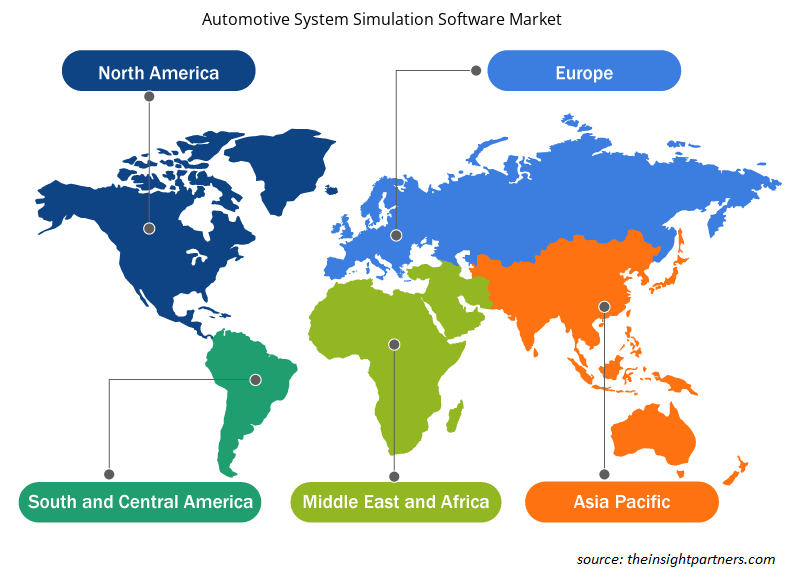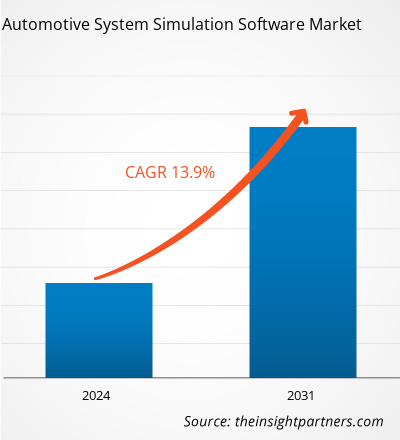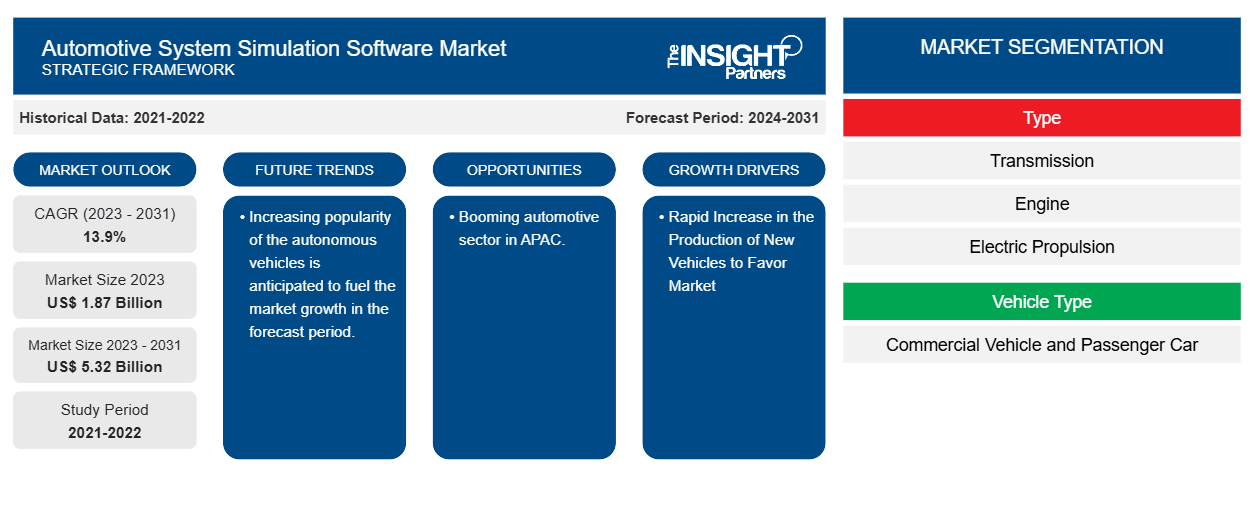汽车系统仿真软件市场规模预计将从 2023 年的 18.7 亿美元增至 2031 年的 53.2 亿美元。预计 2023-2031 年期间,该市场的复合年增长率将达到 13.9%。汽车功能的升级和电子电气部件数量的增加、电动汽车产量和销量的增长可能仍是市场的主要趋势和驱动力。
汽车系统仿真软件市场分析
随着新车产量的快速增长,汽车系统仿真软件市场的需求预计将增长。OEM 正在将其传统的原型设计方法转向汽车系统仿真,以开发新模型并改进现有模型,这推动了汽车系统仿真软件市场的发展。
汽车系统仿真软件市场概览
汽车系统仿真软件 (ASM) 是一个工具套件,包含可根据需要合并的汽车应用仿真模型。这些模型支持广泛的仿真,从内燃机或电动机等单个部件到车辆动力学系统,再到复杂的虚拟交通场景。这些模型可以通过图形用户界面 ModelDesk 轻松直观地处理。
定制此报告以满足您的需求
您可以免费定制任何报告,包括本报告的部分内容、国家级分析、Excel 数据包,以及为初创企业和大学提供优惠和折扣
- 获取此报告的关键市场趋势。这个免费样品将包括数据分析,从市场趋势到估计和预测。
汽车系统仿真软件市场驱动因素和机遇
新车产量快速增长 市场利好
新车产量的快速增长推动了汽车系统仿真软件市场的增长。随着新车产量的增加,对汽车系统仿真软件的需求也在增加。例如,根据欧洲汽车制造商协会 (ACEA) 的数据,2022 年全球机动车产量为 8540 万辆,比 2021 年增长 5.7%。因此,增加新机动车产量可以推动汽车系统仿真软件市场的增长。
亚太地区汽车行业蓬勃发展。
近年来,亚太地区的汽车行业蓬勃发展。快速的城市化、经济繁荣和人口增长推动了这一增长;亚洲国家对人员和货物的流动需求不断增加。此外,汽车正在随着时间的推移而现代化。此外,该地区的起亚、蔚来等公司都专注于产品开发。
汽车系统仿真软件市场报告细分分析
有助于得出汽车系统模拟软件市场分析的关键部分是类型、车辆类型和推进类型。
- 根据类型,汽车系统仿真软件市场分为变速器、发动机、电力推进、燃料电池、传动系统、底盘等。变速器部分预计在预测期内占据最大份额。
- 根据车型,汽车系统仿真软件市场分为商用车和乘用车。商用车领域预计在预测期内占据最大份额。
- 根据推进类型,汽车系统仿真软件市场分为 ICE 和电动。预计 ICE 部分将在预测期内占据最大份额。
汽车系统仿真软件市场份额(按地区)分析
汽车系统模拟软件市场报告的地理范围主要分为五个区域:北美、亚太、欧洲、中东和非洲、南美和中美。
亚太地区占据了市场主导地位。该地区拥有多家专注于现代技术进步的制造商。此外,该地区由新兴经济体组成,包括中国、日本和印度。这些国家拥有重要的汽车工业。此外,城市化和工业化正在增加对大量汽车生产的需求,从而推动了该地区汽车系统模拟软件市场的发展。
汽车系统仿真软件市场区域洞察
Insight Partners 的分析师已详细解释了预测期内影响汽车系统仿真软件市场的区域趋势和因素。本节还讨论了北美、欧洲、亚太地区、中东和非洲以及南美和中美洲的汽车系统仿真软件市场细分和地理位置。

- 获取汽车系统仿真软件市场的区域特定数据
汽车系统仿真软件市场报告范围
| 报告属性 | 细节 |
|---|---|
| 2023 年的市场规模 | 18.7亿美元 |
| 2031 年市场规模 | 53.2亿美元 |
| 全球复合年增长率(2023 - 2031) | 13.9% |
| 史料 | 2021-2022 |
| 预测期 | 2024-2031 |
| 涵盖的领域 | 按类型
|
| 覆盖地区和国家 | 北美
|
| 市场领导者和主要公司简介 |
|
汽车系统仿真软件市场参与者密度:了解其对业务动态的影响
汽车系统仿真软件市场正在快速增长,这得益于最终用户需求的不断增长,这些需求源于消费者偏好的不断变化、技术进步以及对产品优势的认识不断提高等因素。随着需求的增加,企业正在扩大其产品范围,进行创新以满足消费者的需求,并利用新兴趋势,从而进一步推动市场增长。
市场参与者密度是指在特定市场或行业内运营的企业或公司的分布情况。它表明在给定市场空间中,相对于其规模或总市场价值,有多少竞争对手(市场参与者)存在。
在汽车系统模拟软件市场运营的主要公司有:
- ESI集团
- ANSYS公司
- 六角形AB
- dSPACE 公司
- 西门子
- 模特
免责声明:上面列出的公司没有按照任何特定顺序排列。

- 了解汽车系统仿真软件市场顶级关键参与者概况
汽车系统仿真软件市场新闻和最新发展
汽车系统仿真软件市场通过收集一手和二手研究后的定性和定量数据进行评估,其中包括重要的公司出版物、协会数据和数据库。以下列出了汽车系统仿真软件市场的一些发展情况:
- Altair 是计算智能领域的全球领导者之一,该公司宣布已收购 FlightStream 的制造商 Research in Flight,后者提供计算流体动力学 (CFD) 软件,在航空航天和国防领域占有重要地位,在海洋、能源、涡轮机械和汽车应用领域的应用也日益广泛。FlightStream 是一款用户友好且功能强大的流动求解器,可弥补高保真 CFD 模拟与工程师和设计师需求之间的差距。(来源:Altair,公司网站,2024 年 5 月)
- 罗德与施瓦茨与虚拟试驾先驱 IPG Automotive 合作,重新定义汽车雷达硬件在环 (HIL) 集成测试,从而通过将自动驾驶 (AD) 测试从试验场带到开发实验室来降低成本。将 IPG Automotive 的 CarMaker 仿真软件与 R&S AREG800A 雷达物体模拟器和 R&S QAT100 先进天线阵列相结合,汽车制造商能够以可控、安全、省时且低成本的方式模拟欧洲新车安全评鉴协会 (Euro NCAP) 中定义的 ADAS/AD 场景。(来源:罗德与施瓦茨公司网站,2024 年 4 月)
汽车系统仿真软件市场报告覆盖范围和交付成果
“汽车系统模拟软件市场规模和预测(2021-2031)”报告对以下领域进行了详细的市场分析:
- 范围内涵盖的所有主要细分市场的汽车系统模拟软件市场规模和全球、区域和国家层面的预测。
- 汽车系统模拟软件市场趋势以及驱动因素、限制因素和关键机遇等市场动态。
- 详细的 PEST/波特五力分析和 SWOT 分析
- 汽车系统模拟软件市场分析涵盖主要市场趋势、全球和区域框架、主要参与者、法规和最新的市场发展。
- 行业格局和竞争分析涵盖市场集中度、热图分析、知名参与者以及汽车系统模拟软件市场的最新发展。
- 详细的公司简介。
- 历史分析(2 年)、基准年、预测(7 年)及复合年增长率
- PEST和SWOT分析
- 市场规模、价值/数量 - 全球、区域、国家
- 行业和竞争格局
- Excel 数据集
近期报告
相关报告
客户评价
购买理由
- 明智的决策
- 了解市场动态
- 竞争分析
- 客户洞察
- 市场预测
- 风险规避
- 战略规划
- 投资论证
- 识别新兴市场
- 优化营销策略
- 提升运营效率
- 顺应监管趋势





















 获取免费样品 - 汽车系统仿真软件市场
获取免费样品 - 汽车系统仿真软件市场